
Hordeum is a genus of annual and perennial plants in the grass family. They are native throughout the temperate regions of Africa, Eurasia, and the Americas.

Plant viruses are viruses that affect plants. Like all other viruses, plant viruses are obligate intracellular parasites that do not have the molecular machinery to replicate without a host. Plant viruses can be pathogenic to vascular plants.

Brome mosaic virus (BMV) is a small, positive-stranded, icosahedral RNA plant virus belonging to the genus Bromovirus, family Bromoviridae, in the Alphavirus-like superfamily.

Hordeum jubatum, with common names foxtail barley, bobtail barley, squirreltail barley, and intermediate barley, is a perennial plant species in the grass family Poaceae. It occurs wild mainly in northern North America and adjacent northeastern Siberia. However, as it escaped often from gardens it can be found worldwide in areas with temperate to warm climates, and is considered a weed in many countries. The species is a polyploid and originated via hybridization of an East Asian Hordeum species with a close but extinct relative of Californian H. brachyantherum. It is grown as an ornamental plant for its attractive inflorescences and when done flowering for its inflorescence.

Puccinia coronata is a plant pathogen and causal agent of oat and barley crown rust. The pathogen occurs worldwide, infecting both wild and cultivated oats. Crown rust poses a threat to barley production, because the first infections in barley occur early in the season from local inoculum. Crown rusts have evolved many different physiological races within different species in response to host resistance. Each pathogenic race can attack a specific line of plants within the species typical host. For example, there are over 290 races of P. coronata. Crops with resistant phenotypes are often released, but within a few years virulent races have arisen and P. coronata can infect them.

Hordeum murinum, commonly known as wall barley or false barley, is a species of grass, and a close relative of cultivated barley.
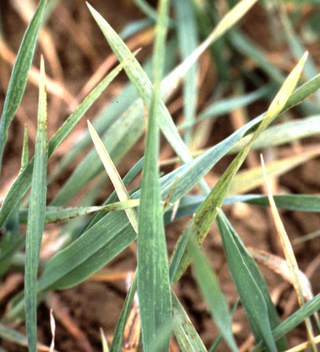
Barley yellow mosaic virus is plant pathogenic virus that causes the yellow mosaic disease of barley. Its shape is categorized as being flexuous filamentous, with lengths of 275 and 550 nanometers. The virus has a limited host range, and barley appears to be the only known susceptible host. The virus is transmitted via Polymyxa graminis, which is a plasmodiophorid protist, through the resting spores that survive in the soil, and eventually zoospores. Eastern Asia is the most affected region, but the virus can be found worldwide. Current agricultural practices have been ineffective at eliminating the virus, but breeding resistance appears to be the only way to help reduce the disease.
Barley stripe mosaic virus (BSMV), of genus Hordevirus, is an RNA viral plant pathogen whose main hosts are barley and wheat. The common symptoms for BSMV are yellow streaks or spots, mosaic, leaves and stunted growth. It is spread primarily through infected seed and can be spread through mechanical transfer of an infected and uninfected host. Plants infected with BSMV are more symptomatic in warmer temperatures. Resistant hosts and sterilization of equipment are the best ways to control the spread of the pathogen. BSMV has been known to reduce the yields of barley by up to 25%, but is not a major problem because of resistant varieties of barley.
Barley yellow streak mosaic virus (BaYSMV) is a plant pathogenic virus.
Wheat yellow leaf virus (WYLV) is a wheat (Triticum spp. L.), barley (Hordeum vulgare L.), rye (Secale cereale M.Bieb.), and oat (Avena sativa L.) pathogenic virus of the family Closteroviridae. WYLV virions are 1600–1850 nm in length and 10 nm in diameter. The virus, like other members of its genus, is transmitted by aphids. Identified vectors include Rhopalosiphum padi L. and R. maidis Fitch. (Aphididae). The virus has been identified in crop plants in Japan, China, and Italy. Native host plants include Italian ryegrass (Festuca perennis Lam.) in Europe and Agropyron tsukushiense var. transiens Ohwi in Japan. The virus proliferates in the phloem of its host plants, interfering with the plant's ability to produce sufficient chlorophyll (Chlorosis), causing the leaves to yellow and the plant to die.

Hordeum pusillum, also known as little barley, is an annual grass native to most of the United States and southwestern Canada. It arrived via multiple long-distance dispersals of a southern South American species of Hordeum about one million years ago. Its closest relatives are therefore not the other North American taxa like meadow barley or foxtail barley, but rather Hordeum species of the pampas of central Argentina and Uruguay. It is less closely related to the Old World domesticated barley, from which it diverged about 12 million years ago. It is diploid.
Hordeivirus is a genus of viruses, in the family Virgaviridae. Plants serve as natural hosts. There are four species in this genus.

Hordeum brachyantherum, known by the common name meadow barley, is a species of barley. It is native to western North America from Alaska to northern Mexico, coastal areas of easternmost Russia (Kamchatka), and a small area of coastal Newfoundland.
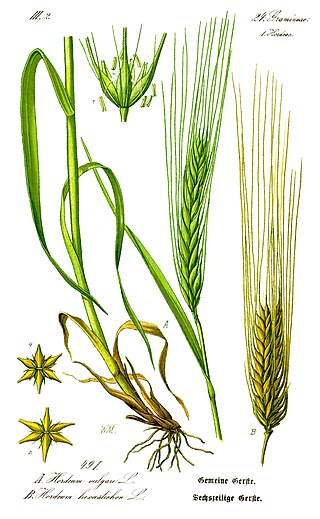
Barley, a member of the grass family, is a major cereal grain grown in temperate climates globally. It was one of the first cultivated grains, particularly in Eurasia as early as 10,000 years ago. Globally 70% of barley production is used as animal fodder, while 30% as a source of fermentable material for beer and certain distilled beverages, and as a component of various foods. It is used in soups and stews, and in barley bread of various cultures. Barley grains are commonly made into malt in a traditional and ancient method of preparation.
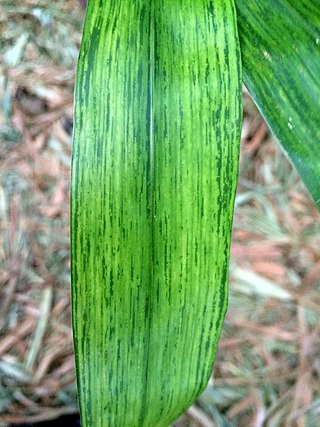
Bamboo mosaic virus (BaMV) is a plant pathogenic virus in the genus Potexvirus and the family Alphaflexiviridae. BaMV is a filamentous, flexuous rod, 490 nm in length and 15 nm in width. The virus has been fully sequenced and it is 6366 nucleotides long.
Hordeum intercedens is an diploid, annual species of wild barley known by the common names bobtail barley and vernal barley. It is native to southern California and northern Baja California, where it is an increasingly rare member of the flora in saline and alkaline soils near seasonal waterflows and vernal pool habitats. Today most occurrences are located on the Channel Islands of California; many of the occurrences known from the mainland have been extirpated in the process of land development. This is an annual grass growing erect to bent in small tufts with stems up to 40 centimeters long. The inflorescence is a green spike up to 6.5 centimeters long made up of awned spikelets between 1 and 2 centimeters long.

Hordeum spontaneum, commonly known as wild barley or spontaneous barley, is the wild form of the grass in the family Poaceae that gave rise to the cereal barley. Domestication is thought to have occurred on two occasions, first about ten thousand years ago in the Fertile Crescent and again later, several thousand kilometres further east.
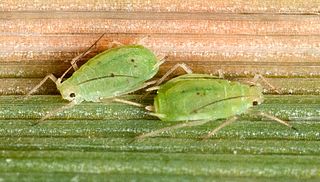
The greenbug, or wheat aphid, is an aphid in the superfamily Aphidoidea in the order Hemiptera. It is a true bug and feeds on the leaves of Gramineae (grass) family members.
Rymovirus is a genus of viruses, in the family Potyviridae. Plants serve as natural hosts. There are three species in this genus.
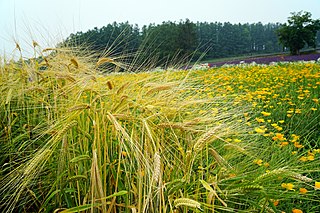
Hordeum distichon, the common barley or two-rowed barley, is a cultigen of barley, family Poaceae. It is native to Iraq, and is widely grown throughout temperate regions of the world. Some authorities consider it a subspecies of six-rowed barley, Hordeum vulgare. It is the principal raw material for malting and brewing beer in Europe, as it is lower in protein than the six-rowed barley usually used in North America.













